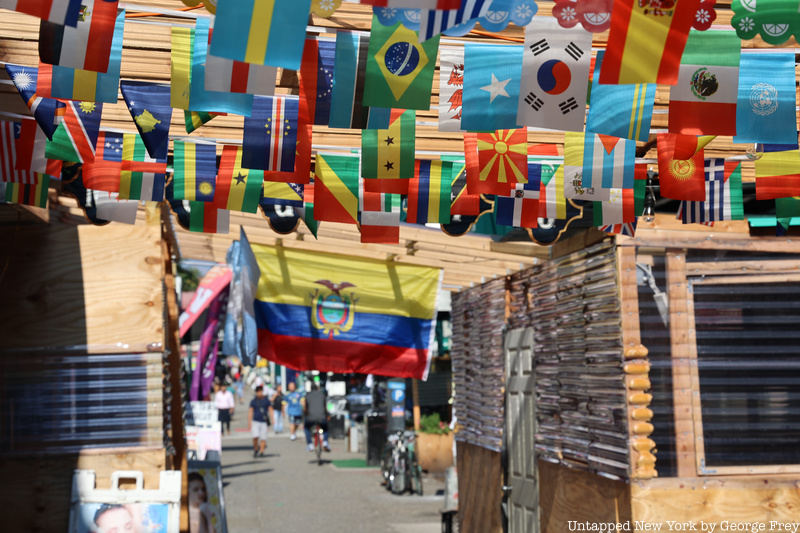
When stepping off the 7, E, and F trains that service Jackson Heights, passengers take in the aromas of fried green onions, sauteed beef, and coriander. Upon exiting the station, they are met with signs in dozens of languages and all sorts of shops. This intermingling of cultures signifies the diversity of Jackson Heights, one of Queens‘ most multiethnic neighborhoods. Hard hit by the coronavirus pandemic, the neighborhood is now bouncing back.
Jackson Heights began as a white middle-class neighborhood, according to the Macaulay Honors College at CUNY, but now hosts multiple ethnic enclaves. With so much packed into a few blocks, the neighborhood hosts many gems all in a tiny radius. Here is an inside peak at one of the most diverse neighborhoods in New York City.
1. Jackson Heights once had an airport
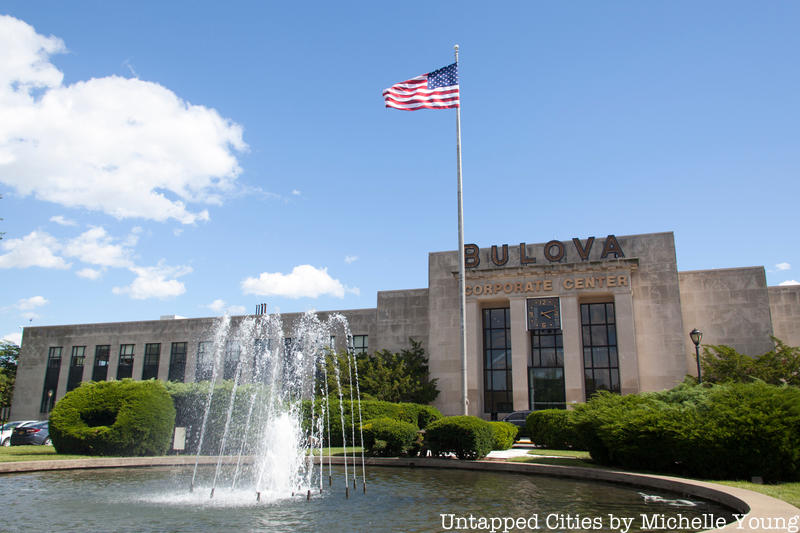
From 1929 to 1940, Holmes Airport operated out of Jackson Heights. Constructed by real estate developer E. H. Holmes, the airport took up 220 acres within an undeveloped area of the neighborhood. During its decade of operation, Holmes airport had two hangars, an office, a flight school, a Goodyear blimp hangar, and two gravel runways. Some of the airport’s first flights departed for Miami in a Ford Trimotor plane.
It was ultimately the opening of La Guardia Airport in 1939 that forced Holmes Airport to close. John F. Kennedy International Airport opened in 1943 and Newark Liberty International Airport opened in 1928, a year before Holmes. A veterans home and Bulova watch factory took its place, and the Bulova Corporate Center sits there today.
2. Jackson Heights is the site of the first Garden City community in the U.S.
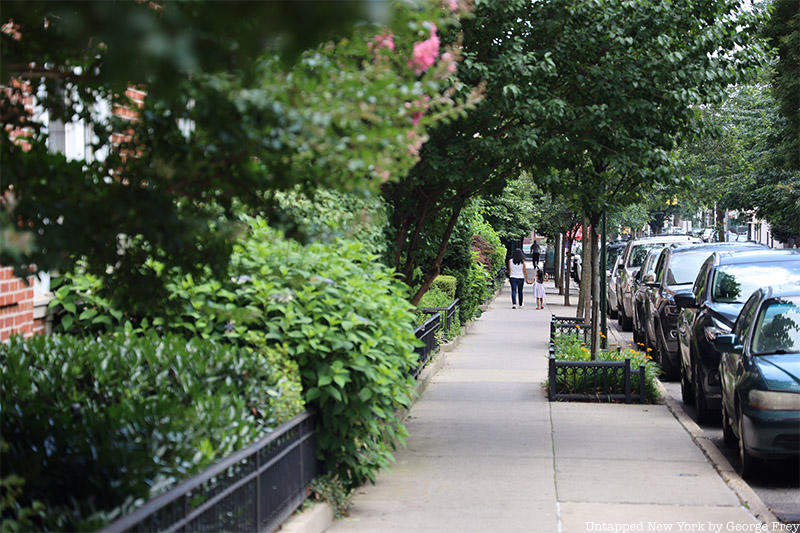
Sir Ebenezer Howard of the United Kingdom created the Garden City Movement, which pushed for planned urban communities surrounded by nature. In these Garden Cities, residents would live in harmony with nature and be free from urban stress. Edward A. MacDougall, founder of the Queensboro Corporation, worked with Howard to create the first Garden City community in the United States in the early 20th century in what would become Jackson Heights.
As development started, Laurel Court became the first Garden City apartment building in the nation. Eventually the Queensboro Corporation hired architect Andrew J. Thomas to further the development of the neighborhood. After the addition of the subway, the influence of the Garden City Movement within Jackson Heights decreased since the area became a commuter neighborhood. Nevertheless, one of Thomas’s most significant additions to the neighborhood is the still extant Linden Court, a 10-building development complex that surrounds green space.
3. Jackson Heights residents speak around 167 languages total
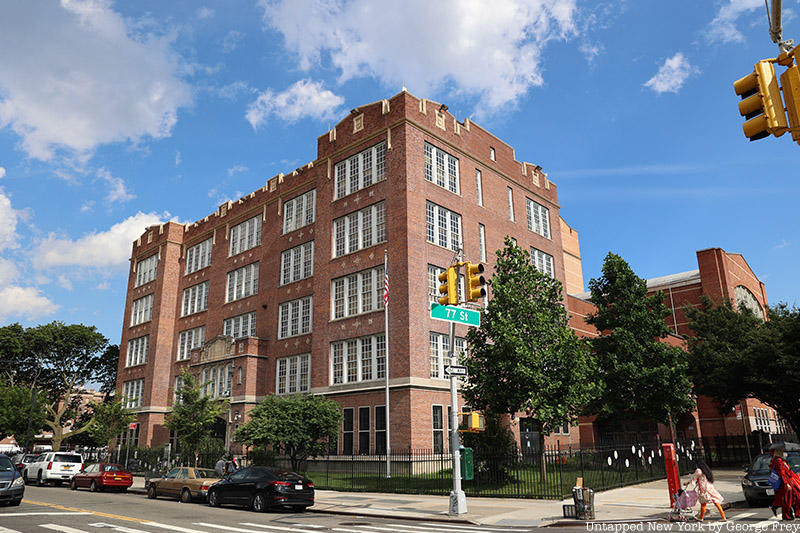
Residents of Jackson Heights claim that 167 languages are spoken within the 300 acres of the neighborhood. According to the Endangered Language Alliance’s Language Map, pockets of people speaking regional languages are common throughout the area, including Tokpe Gola, a language spoken in the Tapkejung region of eastern Nepal; Newari, a language spoken in Kathmandu Valley in Tibet; and Thakali, a language spoken in the Lower Mustang in Nepal. Whereas an estimated 2,000 individuals in New York City speak Newari, only 50 individuals speak Tokpe Gola, many of whom live in Jackson Heights. A few Jackson Heights residents speak Aymara, an Indigenous Bolivian language.
With so many languages spoken throughout the neighborhood, cultural corners have formed over time. Little India sits next to Little Tibet, with Little Colombia nearby. Many more cultural neighborhoods exist within Jackson Heights, making local elementary school PS 69 one of the most diverse in the country. These different ethnic communities often congregate at religious centers including the Jackson Heights Jewish Community Center, the St. Joan of Arc Catholic Church, and the Jackson Heights Islamic Center Mosque.
4. One of the first radio commercials advertised a Jackson Heights apartment
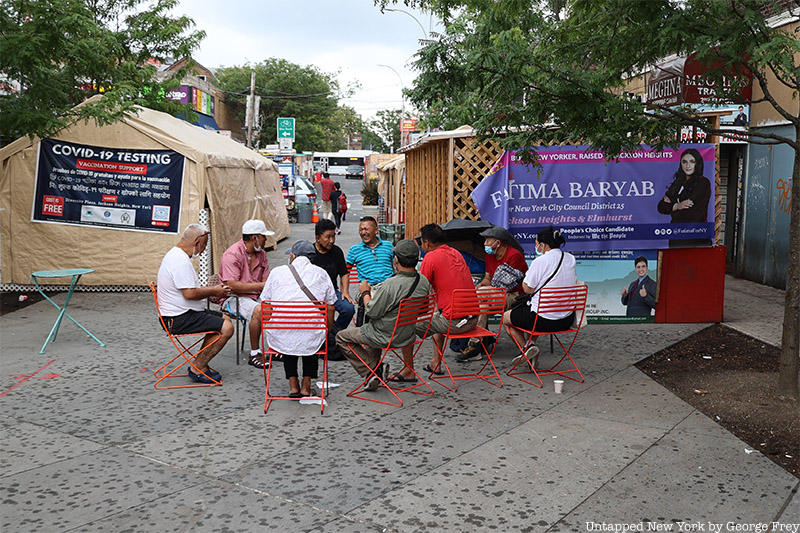
On August 28, 1922, radio station WEAF broadcasted one of the first radio commercials. The radio station, which is now WNBC, played a recording of a soprano singing “Carry Me Back to 01’ Virginny” before allowing a 15-minute talk about the Hawthorne Court apartments in Jackson Heights. The Queensboro Coorporation payed $50 for the Griffin Radio Service to place this advertisement.
Throughout the 15-minute advertisement, a salesman boasted about the openness of the neighborhood, its close proximity to Manhattan, and the close-knit community within an apartment building. With such a long time to set up his pitch, the salesman finally asked listeners to consider living in a Hawthorne Court apartment built by George H. Wells. Three more commercials of this kind were broadcasted to fill the empty apartments of the complex that still exists today.
5. Alfred Mosher Butts, the inventor of Scrabble, is from Jackson Heights
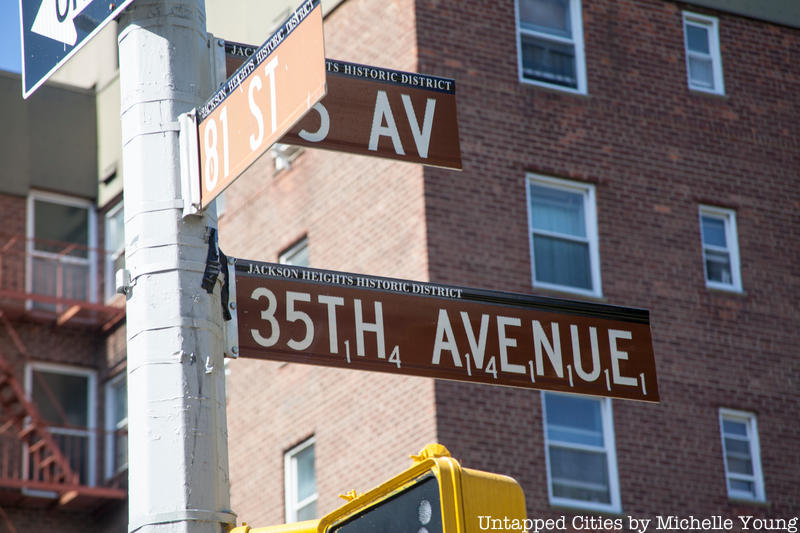
As the Dust Bowl raged on in the Midwest and the Great Depression worsened, Alfred Mosher Butts, an unemployed architect, compared board games to deduce that an annagrams type game with point-values would capture the attention of individuals. Eventually, the Jackson Heights resident would invite friends over to his apartment during the Great Depression to play what he called Criss-Cross, a game centered around creating words to rack up points. After perfecting the rules, pieces, and setup, Butts took the game to the Community Methodist Church on 35th Avenue to spread the word. In 1938, he filed a patent for the game, which he would eventually call Scrabble.
Decades later, a sign appeared on the corner of 35th Avenue and 81st Street in Jackson Heights that denoted the point values for the letters on the sign. The Landmarks Preservation Commission and the Transportation Department both deny any relation to the sign. Although the sign disappeared in 2008, the residents of Jackson Heights and Councilman Daniel Dromm reinstated the sign in 2011.
6. Ittadi Garden & Grill used to be a theater
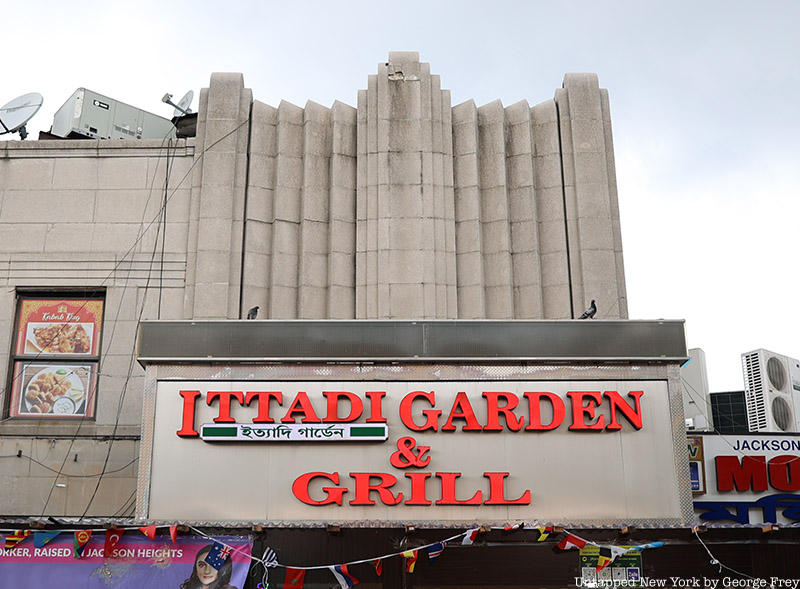
Before Jackson Heights became the extremely diverse neighborhood it is today, it was a white middle-class neighborhood. During this era, architect John Eberson constructed The Earle Theater, along with more than 50 other theaters across the country. This Art Deco cinema showed legitimate films like The Lives of a Bengal Lancer for decades but transitioned to show adult films in the 1970s. The Art Deco style remains in the rising symmetrical roof above the building.
By the 1980s, the theater became the Eagle. Here, the theater showed Bollywood Films, as there was a growing Indian community in Jackson Heights. The Eagle closed in 2009 following an Indian actors’ strike. To this day, a South Asian food court remains called Ittadi Garden & Grill, serving specialties such as samosas, momos, and chicken wings.
7. Food trucks dominate the Jackson Heights food scene
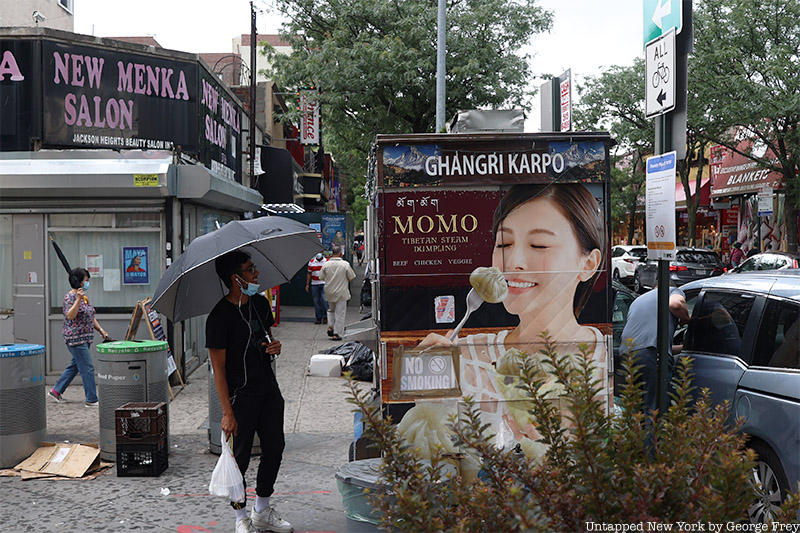
In Jackson Heights, multiple food trucks along with restaurants sell the Nepalese specialty momo. Momos originated in the Katmandu Valley in Nepal where the Newari people still live today. The Newari people typically steamed these dumplings and filled them with yak meat. However, in the United States, momos are typically filled with beef or vegetables. Amdo Kitchen, a food truck run by Thubten Amchok, sells momos by the fives for $8. Amchok is a former monk who has been selling momos for nine years. He fills his momos with ground beef, scallions, salt, and soy sauce surrounded by a sheer skin. Potala Fresh Momo, another food truck in Jackson Heights, sells momos with a thicker skin than those of Amdo Kitchen. Customers can dip beef, vegetable, or chicken momos in a chili sauce dominated by red chili.
New York Times Critic’s Pick, food truck Birria-Landia is often called “Beefrria-Landia” because of a blue light sign on the side of the truck. The truck opens around 5 p.m. on weekdays and around 1 p.m. on weekends and closes after midnight. Lines often curve well around the block with customers eager to consume at least one of the four dishes on the menu: birria tacos, birria tostadas, birria mulita cheese quesadilla, and birria consommé. These menu items are typically bought in pairs, however, as Tijuana locals take a sip of consommé broth after taking a bite of their birria taco. Following birria’s rise in popularity on social media, many now dip birria tacos in the consommé as well. Other New York City birria spots include Las Delicias Mexicanas in East Harlem and El Gallo Taqueria in Brooklyn.
8. Julio Rivera Corner is named after a gay bartender killed by gang members
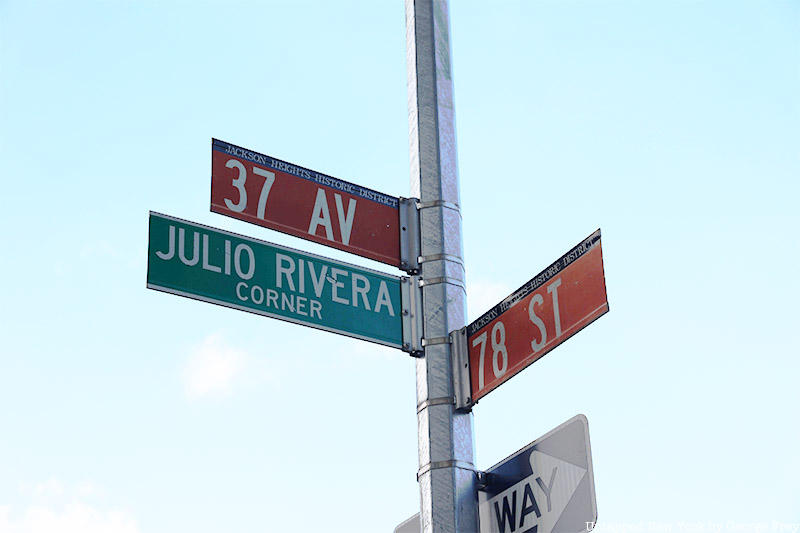
Three gang members in Jackson Heights attacked Julio Rivera, a gay Puerto Rican bartender, in the schoolyard of P.S. 69 in 1990. The perpetrators left Rivera dying on the sidewalk to be found by his former lover Alan Sack and bar owner Tommy Grimaldi. Rivera later died from his injuries in Elmhurst Hospital. His murder became the first gay hate crime to be tried in New York State.
To commemorate his death, the Julio Rivera Corner sits between 37th Avenue and 78th Street. This corner is steps away from where the gang members attacked Rivera with a hammer and knife. Some refer to his murder as Queens’ Stonewall, since it sparked a rise in LGBTQ+ activism in Queens. The murder attracted more attention after Richard Shpuntoff produced his film Julio of Jackson Heights, which premiered at the Queens’ Film Festival in 2016.
9. Jackson Heights hosts the city’s largest concentration of Latino LGBTQ+ bars and nightclubs
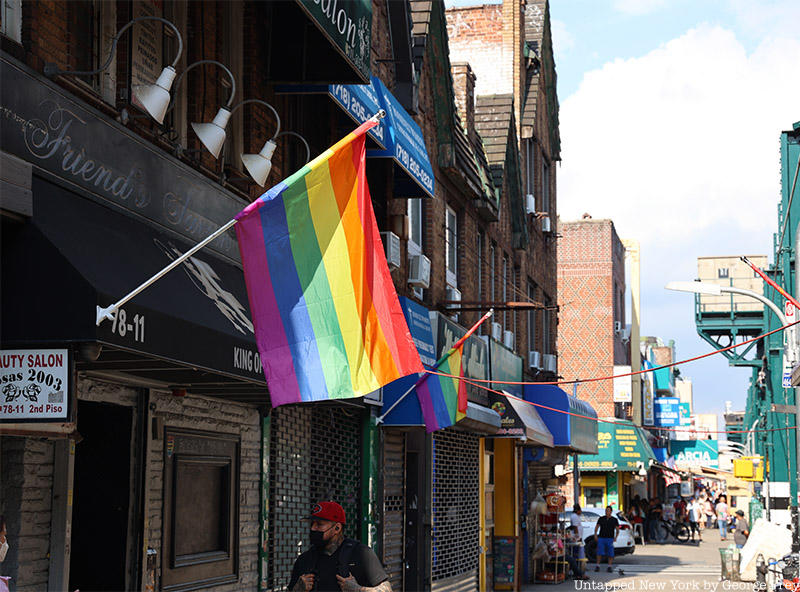
Latino bars called taxi dance halls sit on Roosevelt Avenue in addition to an array of Latino LGBTQ+ bars. These venues in Jackson Heights, including Hombres Lounge and Friends Tavern, make up the largest concentration of Latino LGBTQ+ bars in New York City.
With so many places to socialize in Jackson Heights, members of the LGBTQ+ community have moved to the neighborhood. Jackson Heights now has one of the largest concentrations of LGBTQ+ people in the city. Every year during pride month, residents participate in the Jackson Heights Pride Parade, the second largest Pride parade in the city.
10. Diversity Plaza signifies Queens as the city’s most international borough
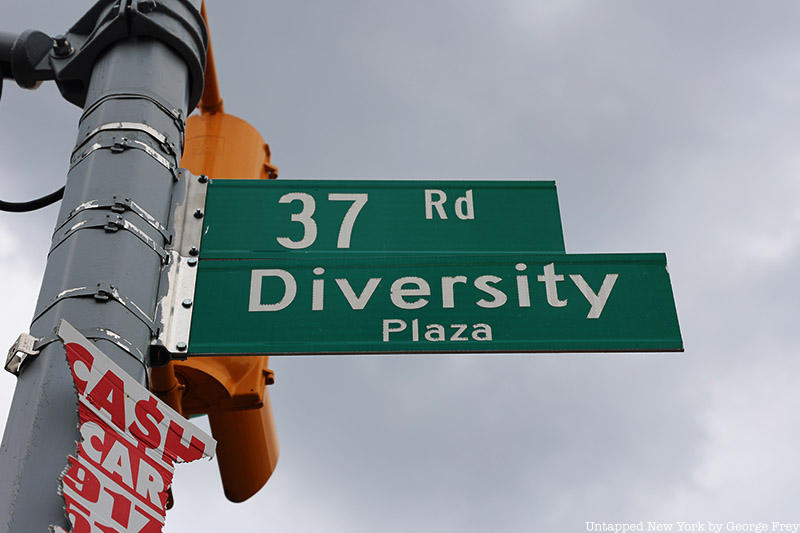
Since its formal installation in 2012, Diversity Plaza at 37th Avenue between 73rd and 74th Streets has been a center for community in Jackson Heights. The plaza maintains pedestrian safety and allows for a large community space. Mayor Bill de Blasio considers Diversity Plaza to be an “epicenter of culture, community, and vibrancy” in Queens.
When a “Momo Crawl” or music performances are not happening around Diversity Plaza, Jackson Heights residents socialize in the square. Many locals chew paan, a betal leaf and areca nut mixture from Southeast Asia. Orange strains dot the concrete of the plaza, since people spit out paan’s orange juice after buying the mixture from local stores including Lucky Paan, Fresh Paan, and Kabab King.
Next, check out the definitive food guide to New York’s many Chinatowns!





